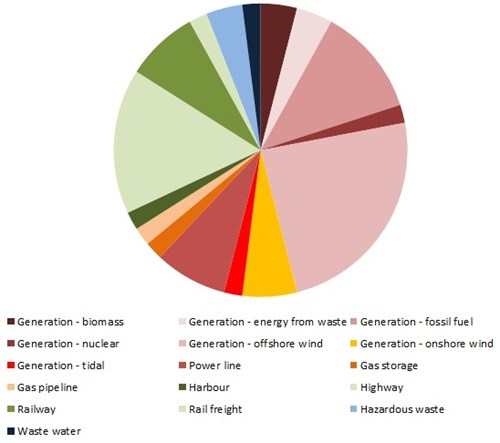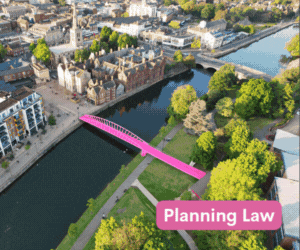Application made for 50th NSIP
 The Planning Act regime for authorising nationally significant infrastructure projects was switched on for applications on 1 March 2010. It's been something of a slow start, but as of yesterday the number of projects for which applications have been made has reached 50, with the application for the 60km long Hinkley Point C electricity connection arriving at the Planning Inspectorate in Bristol. It's a big one, too, with over 60 boxes of documents and 2000 A1 plans. Time for a bit of analysis.
The Planning Act regime for authorising nationally significant infrastructure projects was switched on for applications on 1 March 2010. It's been something of a slow start, but as of yesterday the number of projects for which applications have been made has reached 50, with the application for the 60km long Hinkley Point C electricity connection arriving at the Planning Inspectorate in Bristol. It's a big one, too, with over 60 boxes of documents and 2000 A1 plans. Time for a bit of analysis.
- Details
I should first say that the title of this post has had to be worded carefully because 52 applications have actually been made - the Planning Inspectorate and the Infrastructure Planning Commission before it have received 52 application fees - but two of these were made twice. Those were for the Rampion offshore wind farm and the Daventry International Rail Freight Terminal extension, the first having been withdrawn and the second rejected; they were both re-made successfully. But since projects rather than applications are really the thing, it is more noteworthy to mark 50 projects than 50 applications.
It's a remarkable coincidence that it has taken four years and two months for the 50th project. What's so special about four years and two months? That makes 50 months, that's what. The application rate has therefore been a steady one per month.
That doesn't seem much at first glance, considering that PINS deals with over 15,000 planning appeals each year, but there is a singificant difference in the scale of nationally significant infrastructure projects (NSIPs) compared with other applications. To take the largest example, the Thames Tideway Tunnel, Thames Water estimated that they submitted over 125,000 pages of information to PINS as part of its application and subsequently, and that was only one of the parties involved. The PINS website contains nearly 2500 documents for that project alone. To be fair, that project is unrepresentative, but by my calculations the average number of documents on the PINS website for applications that have at least completed their examinations is 518.
What of the types of application? Electricity generation is just in the majority, with 27 projects, and the most popular form of that is offshore wind, with 12 projects, three more being onshore wind. Thus wind energy makes up 30% of the applications overall. If a cynic (not me, obviously) might say that the Planning Act was introduced by the last Labour government to deliver a new runway at Heathrow and a new generation of nuclear power stations then it has not succeeded yet, as there have been no airport applications and just one for a nuclear power station. However in practice it has done rather well as a delivery mechanism for large offshore wind projects, cementing the UK's position as the world's largest user of offshore wind.
The full tally is 27 electricity generation projects breaking down into two biomass, two energy from waste, six fossil fuel, one nuclear, 12 offshore wind farms, three onshore wind farms, one tidal; then other energy: four power lines, one gas storage and one gas pipeline; transport: one harbour, six highways, four railways and one rail freight interchange, and finally two hazardous waste facilities and one waste water project. A pie chart is below, with the reddish ones energy, the greenish ones transport and the bluish ones waste.

Applications have not been without their problems, indeed the first application was rejected, the second is still in litigation and the third was withdrawn, and only last week the 49th project's application was withdrawn on the day it was due to be accepted or rejected for examination. That made five applications to be withdrawn after having been made, two rejected for examination and one refused by the Secretary of State at the decision stage, although that one, the Preesall gas storage project, is now being reconsidered following a successful High Court challenge. That's only eight out of 50, though. 17 have made it all the way through to consent being granted so far; the rest are at various stages of consideration.
Finally, after nearly five years of blogging (me) and working hard (everyone else at BDB), the chances were good that the 50th application would be one we were acting on, and indeed that has proved to be the case. It takes us to 22% of all the applications made so far, 35% of the successful consents - and 0% of the ones that didn't make it. Here's to the next 50!
- See more at: http://www.bdb-law.co.uk/news-and-views/blogs/planning-act-2008/2014/may/554-application-made-for-50th-nsip/#sthash.PNktUojH.dpuf
Lawyer - Property
Trust Solicitor (Employment & Contract Law)
Senior Lawyer - Contracts & Commercial
Contracts & Procurement Lawyer
Locums
Poll









































